Speech The Financial Cycle and Recent Developments in the Australian Financial System

Philip Lowe
Assistant Governor (Financial System)
6th Annual Retail Financial Services Forum
Sydney –
It is a pleasure to be able to address this year's Retail Financial Services Forum. As you know, this is the sixth year that the Forum has been held and I think it is fair to say that the current environment is more challenging than at any time over that six-year period. The global financial system is having to deal simultaneously with a very large repricing of risk, an unwinding of the leverage built up over recent years, shaken confidence in many financial institutions, and rising problem loans. As a result, many banks around the world are facing the most difficult operating environment for many years.
Given the scale of these adjustments in the global system, it is hardly surprising that the Australian system too has felt their impact. Bank equity prices are down, funding costs are up, the competitive dynamics in the system have changed, and provisioning charges have increased. The system has, however, coped much better than the financial systems of many other countries. The Australian banks continue to record healthy profits, have low loan arrears in both absolute terms and by international standards, and have sound capital levels. Overall, Australia has been well served through the recent turmoil by the fundamental strength of its banking sector and the financial system more generally. It has also been well served by its regulatory regime, which is widely recognised to have worked well through the recent turmoil.
In my remarks this morning, I would like to begin by discussing some of these recent trends in more detail. In particular, I would like to touch on the issues of profitability, credit quality and funding. I would then like to lift the gaze a little from what has been going on very recently, to focus on one of the many longer-term issues on which the spotlight has fallen in recent months. And that is the way in which financial institutions and regulators respond to the inevitable cycles in the financial system. This issue is important because the current problems did not simply arise out of thin air, but rather had their origins in the global boom over recent years. While the next financial crisis will surely look different to the current one, there is a fair chance that it too – like most crises in the past – will have its origins in a financial boom. Dealing with these booms, and the seemingly inevitable busts, is a major challenge for all of us involved in the financial sector.
Bank Profitability
As is well known, the profitability of many banks around the world has been severely dented by recent events. Nowhere is this more evident than in the United States, with data published by the FDIC showing that in the six months to March this year, the aggregate profits of FDIC-insured banks were down 70 per cent on the level a year ago (Graph 1). The decline has been particularly pronounced for the largest banks, with the six biggest commercial banks collectively incurring a loss over the past three quarters. In Europe, the profitability of many banks has also been significantly diminished, with the aggregate profits of the largest banks that have recently reported half-yearly results being down by around 70 per cent on the level a year ago.
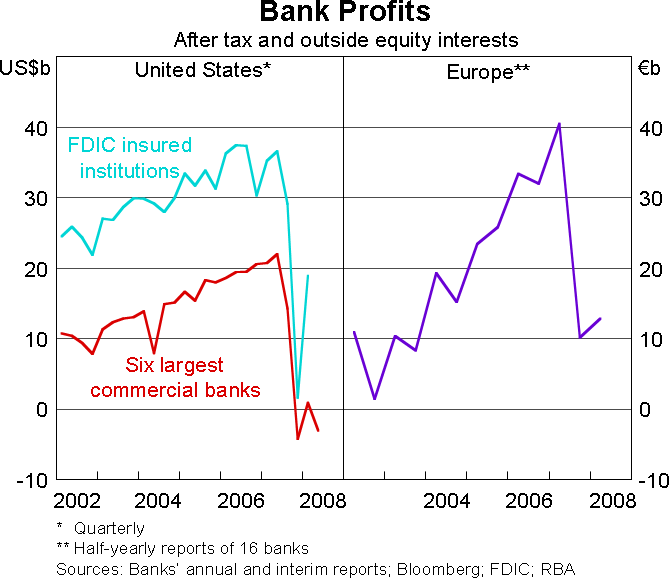
In contrast, the Australian banking system remains highly profitable by international standards. Over the most recent six-month reporting period, profits after tax (and outside equity interests) for the five largest banks were up 12½ per cent on the level of a year earlier and were double those of five years ago (Graph 2). Looking forward, some decline in aggregate profits is expected by banking analysts, with a couple of the large banks recently announcing higher provisioning expenses for the second half of the current financial year. Despite this, their forecasts suggest that the annualised after-tax return on equity for the largest banks over the second half of the year will still be around 15 per cent, not that far below the average of the past decade (Graph 3).
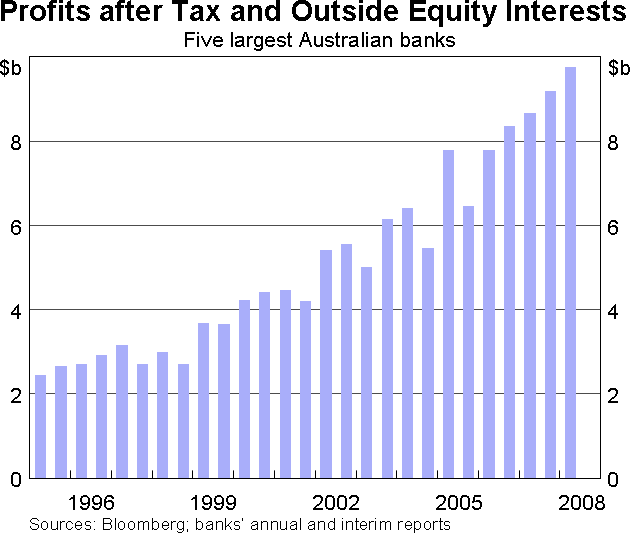
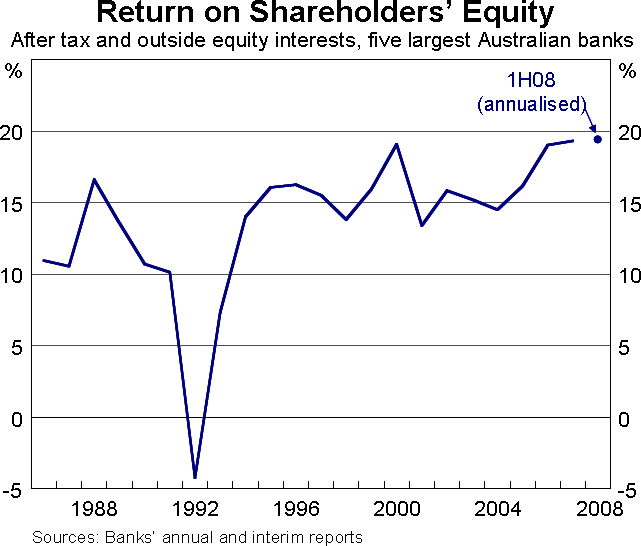
These strong profit outcomes are reflected in the high credit ratings of the Australian banks, with the four largest banks all having AA ratings. Consistent with these high ratings, the system is soundly capitalised, with the aggregate regulatory capital ratio around 10.5 per cent, similar to its average level over the past decade. It is notable that amongst the largest 100 banks in the world, there are less than a handful with higher ratings than those of the large Australian banks (Graph 4). And, unlike the situation in some other countries, the larger Australian banks have not been forced to raise significant amounts of new capital to cover writedowns.
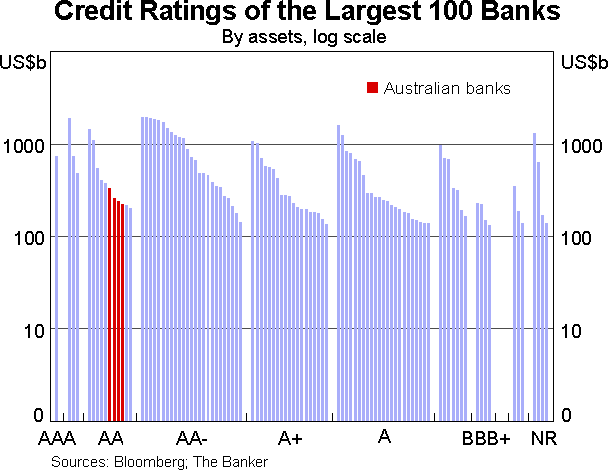
While the recent increases in provisions came as a surprise to the market, many commentators have noted that a prerequisite for a return to more normal conditions in global markets is for financial institutions to make clear and accurate statements about their exposures. This is because nothing is more corrosive of confidence in the financial system than concerns that losses are being hidden or not fully disclosed. If bad investments have been made, it is better to acknowledge them, take the punishment, and move forward.
In the current environment, therefore, all financial institutions need to consider how best to strengthen the bond of trust between themselves and investors. Developing a reputation for full, frank and comprehensive disclosure is obviously important here. By and large, Australian banks have done well in this regard, although further steps can always be taken to provide the comprehensive information that investors require. Reflecting this, the Reserve Bank has strongly encouraged Australia's leading financial institutions to provide disclosures consistent with the template set out in the recent Financial Stability Forum report on Enhancing Market and Institutional Resilience[1].
Credit Quality
One of the long-standing positive aspects of the Australian system is the relatively low arrears rates on Australian residential mortgages. Currently, just over 0.4 per cent of banks' mortgages are more than 90 days in arrears, with the comparable figure for loans that have been securitised being 0.55 per cent (Graph 5). These figures have increased from the very low levels seen between 2002 and 2004 – and are likely to increase further with the economy slowing – but remain considerably below comparable figures for many other countries. In the United States, for example, around 2.2 per cent of banks' residential mortgages are non-performing (Graph 6). And in the United Kingdom, around 1.3 per cent of the number of loans is in arrears by 90 days or more.
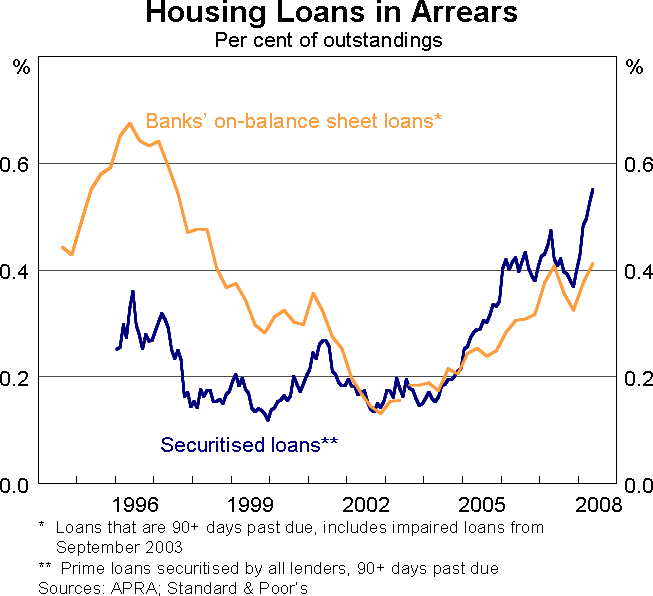
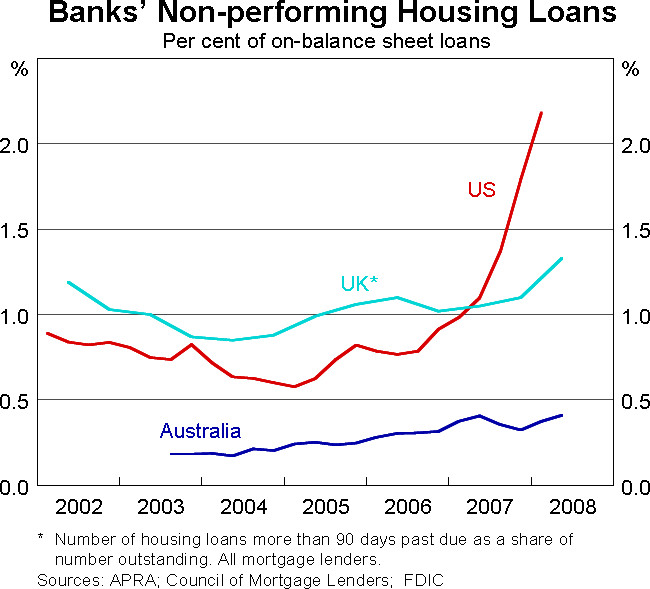
There are a number of reasons for this comparatively favourable experience in Australia. One is that the competitive excesses that saw a dramatic lowering of credit standards in the mortgage market in the United States did not occur here. While credit standards in Australia were eased considerably, increasing the availability of credit to many people, we have escaped the worst of the excesses seen in the United States.
One reason for this is that financial conditions in the United States were much more accommodative than they were in Australia. This made it possible for many US households with limited repayment ability to obtain loans, with many borrowers anticipating that increases in house prices would create the wherewithal to repay the loan. Another explanation is that APRA has pursued a relatively activist regulatory approach, tightening up prudential requirements on housing loans over recent years, and increasing the attention it has paid to banks' mortgage exposures. And third, the big lift in aggregate house prices in Australia took place between 1996 and 2003, prior to that in a number of other countries. Looking back, this timing can be seen as partly fortuitous. It meant that just at the time that financial innovation was accelerating around the world and investors were looking for new higher-yielding assets, Australian households were digesting the big run up in debt and house prices that had occurred earlier in the decade. While many households' finances are undoubtedly currently strained, the aggregate position of the household sector is in better shape than it would have been had the housing boom run on longer and coincided with these developments in the global system.
Another factor underpinning the historically positive record is the legal and regulatory arrangements in Australia. The Uniform Consumer Credit Code means that courts can set aside mortgage agreements where the lender could have reasonably known that the borrower could not repay the loan without substantial hardship. In addition, unlike in some parts of the United States, Australian mortgages are ‘full recourse’ so that a borrower cannot simply hand in the keys and extinguish the debt. These aspects of the legal framework serve a useful purpose, helping to focus the minds of both lenders and borrowers on the risks of entering into a loan contract.
Looking beyond the banks' housing portfolios, the ratio of non-performing assets to total assets also remains low by both historical and international standards, at 0.56 per cent (Graph 7). While some banks have had to make increased provisions against loans to borrowers with complicated and leveraged financial structures, the banks' broader business loan portfolios are continuing to perform well. Reflecting this, the non-performing loans ratio remains below the average for the decade from the mid 1990s to the mid 2000s.
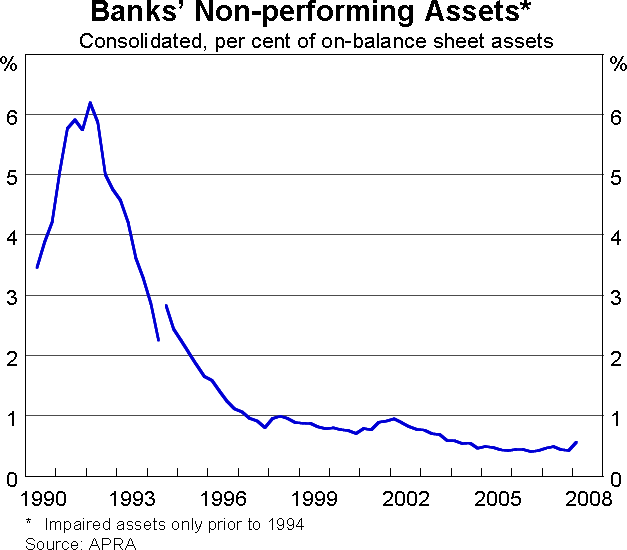
Furthermore, the Australian banks have not been heavily involved in the sub-prime and related markets in the United States, and earn less of their revenues from trading in financial markets than many overseas banks. Some have, however, incurred indirect exposures to the sub-prime problems through a variety of channels. One of these is the liquidity lines that were granted to sponsored vehicles that financed themselves in the short-term commercial paper market and purchased sub-prime-related assets. When the commercial paper market closed to these vehicles, the liquidity lines were drawn, with the banks providing the liquidity finding themselves lending to these vehicles. Given that the price of the underlying assets has fallen dramatically, the ability of some of these vehicles to repay their loans has been compromised. To a significant extent the motivation for the establishment of these entities was to reduce regulatory capital requirements, with a number of overseas banks taking the process much further than we have seen in Australia. Reflecting this, regulators around the world, including here in Australia, are looking at how this type of activity can be addressed, and banks too are no doubt assessing the risks.
Despite the relatively favourable position of the Australian banking system, bank share prices in Australia have fallen considerably, as they have around the world. Since its peak in October 2007, the bank share price index is down by around 30 per cent, the largest cumulative decline since the early 1990s (Graph 8). In comparison, share prices of commercial banks in the United States are down by around 35 per cent over the same period, while those in the United Kingdom are down by 32 per cent. Taking a somewhat longer perspective, the Australian banking sector has considerably outperformed those in many other countries, with bank share prices up by nearly 25 per cent on their level at the beginning of 2004, compared with falls of between 20 and 25 per cent in the United States and United Kingdom over the same period.
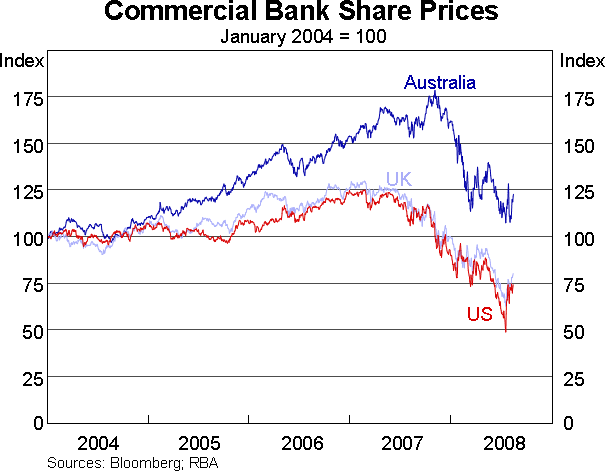
Funding
One aspect of recent events that has drawn considerable attention is the funding costs of banks. As is now well understood, banks around the world have faced significant increases in the spreads over risk-free rates that they have to pay for their funds. This increase reflects both a rise in the amount of compensation that investors require for accepting risk generally, and a rise in the perceived riskiness of many banks.
Not surprisingly, the Australian banks have been affected by this repricing. At the short end of the yield curve, the spread between the 90-day bank-bill rate and the OIS rate has recently averaged around 35 basis points higher than it was in mid 2007, while at the long end, the spread between the yield on bank bonds with 3–5 year maturities and the bank bill swap rate is up by around 90 basis points (Graph 9).
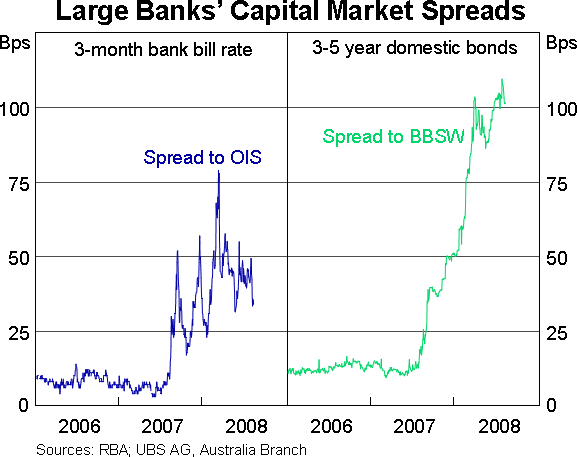
These higher funding costs have been passed onto borrowers, with mortgage rates increasing by around 55 basis points more than the increase in the Reserve Bank's cash rate over the past year. They have also had a considerable impact on the competitive dynamics in the system, with lenders financing mortgages through the securitisation market facing a more significant increase in their costs than have the banks. At current spreads, these lenders face difficulties in making profitable prime housing loans at the rates that the banks are charging for these loans. As a result, their share of approvals for new owner-occupied housing loans has fallen from around 13 per cent in the middle of last year to just over 4 per cent (Graph 10). Conversely, the share accounted for the banks has increased significantly.
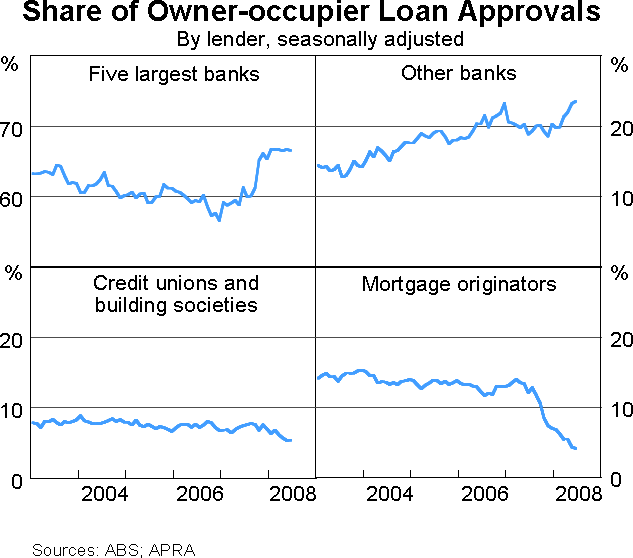
These changes in the competitive position of different lenders are probably best thought of as cyclical, rather than structural. During a period in which risk is being repriced and uncertainty has increased, it is not surprising that those lenders relying most heavily on the capital markets have suffered a decline in their competitive position. When conditions improve, as they inevitably will, these lenders will find that their competitive position also improves. In the meantime, the extent to which banks are able to increase their borrowing rates is constrained both by competition amongst themselves, and the fact that higher margins make it more likely that lenders funding through the securitisation markets will again find it profitable to make housing loans. A widening of margins also risks raising the ire of the public.
Given the assessment that the recent changes in the competitive landscape are largely cyclical, the Reserve Bank does not see a case for permanent government intervention in the mortgage market. Over the past couple of decades, a lack of housing finance has not been a problem in Australia. We have had a very competitive private mortgage market which has offered a wider range of mortgage products to consumers than that seen in many other countries. While the availability of finance has tightened up recently, over the longer term we do not expect that a shortage of housing finance will be one of the problems that Australia will have to confront. Furthermore, as we have seen in other countries, the creation of permanent government structures in this market can have unintended consequences.
Another notable feature of the recent experience has been a strong increase in competition for deposits, with many banks lifting their interest rates on both at-call and term deposits. As a result, it has become common for some banks to offer retail customers interest rates at, or above, those available in the short-term money market, although people investing in high-yield term-deposit ‘specials’ need to be aware that at maturity the funds may roll into a new deposit with a much lower interest rate.
This increase in competition in deposit markets has coincided with a renewed appetite by Australians for bank deposits. According to the Westpac and Melbourne Institute Survey of Consumer Sentiment, more people now say that bank deposits are a wiser place for their savings than real estate or shares (Graph 11). This is the first time that this has been the case for more than two decades. As a result, bank deposits are growing very quickly, increasing by 18 per cent over the past year, the fastest growth for many years (Graph 12). Term deposits by the household sector have grown even faster, up 40 per cent over the past year. Not surprisingly, many banks are now paying more attention to how best to attract and retain depositors.
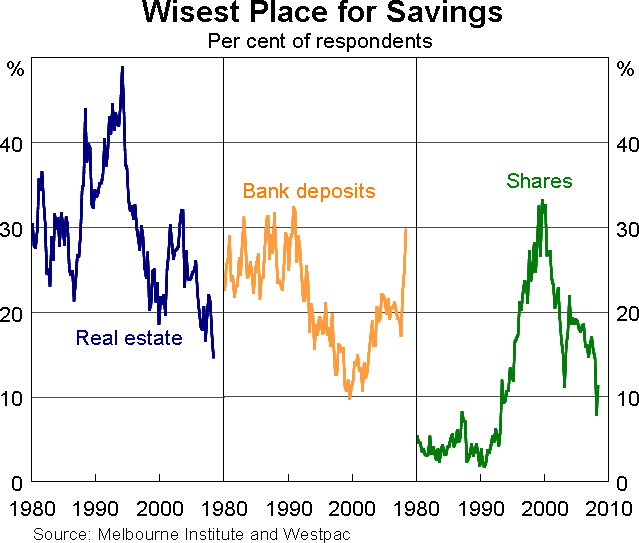
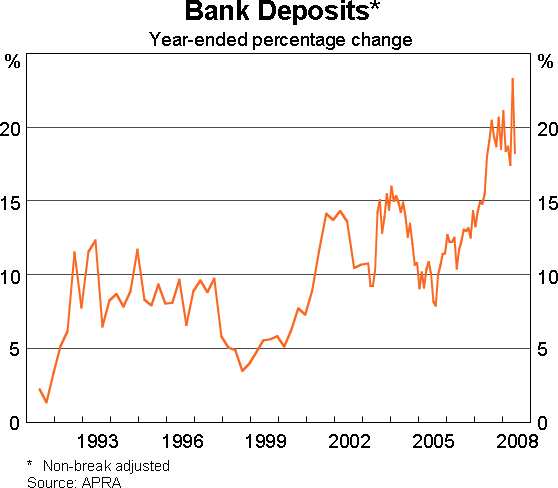
Importantly, throughout the turmoil of the past year, the large banks have also retained access to both the domestic and international capital markets. While they have had to pay more for funds, they have been able to obtain the funds they need to expand their balance sheets. Earlier in the year in particular, they issued a significant volume of bonds in the offshore markets, and they continue to tap both onshore and offshore markets on a regular basis (Graph 13). While at times, investors do not seem to have shown very much discrimination amongst banks around the world in terms of market prices, the ability of Australian banks to continue to raise significant volumes of funds is a positive reflection of their underlying strength.
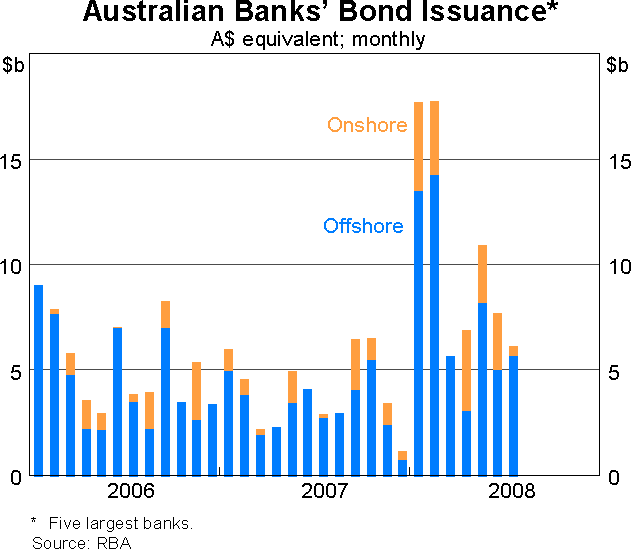
The Financial Cycle
I would now like to change gear and turn briefly to the longer-term issue that I raised at the outset – that is, dealing with the financial cycle. As I said, this is a challenging issue for us all, and one that has taken on more importance over time, particularly as the size of the financial sector has grown relative to the size of the overall economy. This growth means that swings in the financial sector have a greater potential to materially affect the economy, both in the upswing and the downswing, than was once the case.
It is all too clear that most episodes of financial disturbances have their roots in the build up of risk in good times. While the specifics differ from episode to episode, there are some obvious common elements. In the boom, when economic conditions are benign and asset prices are rising, many investors perceive risk to be low and are prepared to borrow large amounts of money to purchase assets, with lenders all too willing to provide the finance. This reinforces the general sense of well being, with asset prices rising further and many people being emboldened to borrow even more. Given the sense of optimism, many people seek new and more risky ways of maintaining inflated expectations of returns, including by increasing their leverage, and the whole process is typically given extra fuel by a spurt of innovation in the financial sector. Those who caution that the good times may not continue are drowned out by this flood of optimism.
And then something happens to put the whole process into reverse. The risk built up in the good times quickly crystallises. Assets prices fall, leverage needs to be reduced, a sense of pessimism pervades, and many people question why they, or at least their investment advisors, did not see the turnaround coming. This depiction is admittedly highly stylised, but it is not too far from the mark in describing events over recent years, or for that matter many other financial cycles.
The difficult policy question is what, if anything, should be done about this. This question is now moving to centre stage in discussions of the global financial architecture, with the Financial Stability Forum identifying it as one of the major issues to be addressed in the fallout from the sub-prime problems.
While there is no shortage of ideas of what could be done, there are no easy answers. Some people suggest that the remuneration arrangements within financial institutions need to be redesigned. The concern here is that current arrangements encourage short-termism, with the risk metrics used in the remuneration process paying too little attention to risks that are likely to crystallise only in the medium term. Another idea is that the valuation approaches for many assets need to be reconsidered, particularly for those which trade in very illiquid markets. A third idea is that monetary policy should lean against a financial boom, particularly if significant debt-financed imbalances are building up in the system. And yet a fourth idea is that financial institutions should build-up their capital buffers in the good times, with these buffers being available in more troubled conditions. This could be achieved through regulation or by financial institutions taking a more active approach in dealing with the economic cycle.
Each of these ideas has its pluses and its minuses. Rather than talk about them all in detail, I would like to touch just briefly on the last of these ideas – that is, for the banking system to build up the size of its capital buffers in the good times. I focus on this issue not because it is necessarily the most promising of these various ideas, but rather because it is currently under discussion in a number of international forums, and it illustrates the difficult trade-offs involved.
On the one hand, increasing capital buffers in the good times is likely to reduce the need for banks to raise capital when times are tough. This might help smooth out some of the swings in the lending cycle. An increase in capital could be achieved by banks retaining on their balance sheet a slightly higher share of their profits in good times where credit losses are unusually low, rather than paying the profits to shareholders in the form of dividends. Increasing capital buffers in good times might also be one way of guarding against some of the moral hazard concerns that can arise if the public sector is prepared to assist markets, and even institutions, during more troubled times.
On the other hand, higher capital ratios can increase the cost of financial intermediation and could distort the competitive position of different institutions in the financial system. Also, if institutions are forced by regulation to hold more capital than they think is justified, they are likely to seek ways of avoiding the requirements. As the recent experience with conduits, SIVs, and 364-day credit lines cautions, the result paradoxically can be an increase in overall risk in the financial system. Finally, there are also considerable implementation challenges facing any attempt by regulators to introduce a regime in which minimum capital requirements change over the course of a business or financial cycle.
As I said these are not easy issues. The trade-offs are difficult and the implementation challenges are considerable. The same is true for each of the other ideas that I mentioned a few minutes ago. Despite this, finding ways of dealing with financial cycles is important if we are to maintain the broad community consensus that has supported financial liberalisation and globalisation over recent decades.
Thank you very much for your time.
Endnote
See <http://www.fsforum.org/publications/r_0804.pdf>. [1]